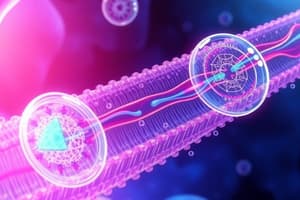Podcast
Questions and Answers
What is passive transport?
What is passive transport?
- The movement of substances across a cell membrane without the use of energy by the cell (correct)
- The process of molecules being actively transported
- The process of molecules diffusing from high to low concentration
- The movement of substances with energy
What is diffusion?
What is diffusion?
Movement of molecules from an area of higher concentration to an area of lower concentration.
What is a concentration gradient?
What is a concentration gradient?
The difference in the concentration of molecules across a distance.
What does equilibrium mean in the context of cellular transport?
What does equilibrium mean in the context of cellular transport?
What is osmosis?
What is osmosis?
What is a hypotonic solution?
What is a hypotonic solution?
What is a hypertonic solution?
What is a hypertonic solution?
What is an isotonic solution?
What is an isotonic solution?
What is a contractile vacuole?
What is a contractile vacuole?
What is turgor pressure?
What is turgor pressure?
What is plasmolysis?
What is plasmolysis?
What is cytolysis?
What is cytolysis?
What is facilitated diffusion?
What is facilitated diffusion?
What is a carrier protein?
What is a carrier protein?
What is an ion channel?
What is an ion channel?
What is active transport?
What is active transport?
What is the sodium-potassium pump?
What is the sodium-potassium pump?
What is endocytosis?
What is endocytosis?
What is phagocytosis?
What is phagocytosis?
What is a phagocyte?
What is a phagocyte?
What is exocytosis?
What is exocytosis?
Flashcards are hidden until you start studying
Study Notes
Cell Transport Concepts
- Passive transport: Movement of substances across cell membranes without energy expenditure.
- Diffusion: Molecules move from high concentration areas to low concentration areas until equilibrium is reached.
- Concentration gradient: The difference in molecular concentration between two areas influences molecular movement.
- Equilibrium: Achieved when molecular concentrations are uniform throughout a space.
Water Movement
- Osmosis: Water molecules diffuse through a membrane from higher to lower concentration.
- Hypotonic solution: Has a lower solute concentration than the inside of a cell, potentially causing cells to swell.
- Hypertonic solution: Contains a higher solute concentration than the inside of a cell, which may lead to cell shrinkage.
- Isotonic solution: Solute concentration is equal inside and outside the cell, maintaining cell shape.
Cell Structures and Functions
- Contractile vacuole: An organelle in protists that helps regulate osmotic pressure by expelling excess water.
- Turgor pressure: Internal pressure due to water entering plant cells, essential for maintaining structure.
- Plasmolysis: Occurs when a plant cell's membrane contracts in a hypertonic solution due to water loss.
Cell Viability
- Cytolysis: The rupturing of a cell due to excess inward water movement.
Active Transport Mechanisms
- Facilitated diffusion: Substances move across membranes via carrier proteins along concentration gradients.
- Carrier protein: A specialized protein that assists in the transport of substances across membranes.
- Ion channel: Protein complexes forming pores allowing selective ion passage.
Energy-Dependent Processes
- Active transport: Movement of substances against concentration gradients requiring energy.
- Sodium-potassium pump: A specific carrier protein that uses ATP to transport sodium out and potassium into cells.
Endocytosis and Exocytosis
- Endocytosis: The process by which cells engulf particles, forming vesicles to bring materials into the cell.
- Phagocytosis: A type of endocytosis where cells engulf large particles or other cells.
- Phagocyte: A cell specialized for engulfing and destroying foreign substances.
- Exocytosis: The process of expelling substances from a cell through vesicle fusion with the membrane.
Studying That Suits You
Use AI to generate personalized quizzes and flashcards to suit your learning preferences.




